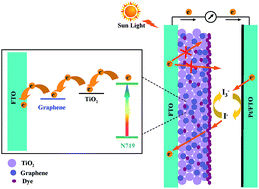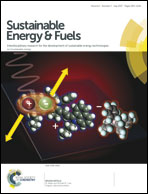Construction of efficient photoanodes for dye sensitized solar cells: TiO2 films with a gradient content of graphene
Abstract
Graphene has attracted a lot of attention because of its unique optical, thermal, mechanical and electrical properties. In this study, the effect of graphene on the performance of dye sensitized solar cells (DSSCs) was investigated by constructing TiO2 photoanodes with a gradient graphene content. After the construction of photoanodes with a gradient graphene content, the DSSCs displayed a higher dye loading amount, lower internal resistances, lower electron recombination rate and faster electron transport rate, which resulted in high open circuit voltage and current density. Under the optimum conditions, the DSSC exhibited a Voc of 0.72 V, a Jsc of 17.11 mA cm−2, a FF of 0.63, and an energy conversion efficiency (η) of 7.71%, indicating a 41% increase in η than that of the DSSC based on a pure TiO2 photoanode, which gives a Voc of 0.69 V, a Jsc of 12.63 mA cm−2, a FF of 0.62, and an η value of 5.45%. The construction of TiO2 photoanodes with a gradient graphene content could really enhance the efficiency of DSSCs by improving the dye loading amount and enhancing the electron bridge effect of graphene from TiO2 to the FTO, which lowered the electron recombination rate and accelerated the electron transport rate.



 Please wait while we load your content...
Please wait while we load your content...